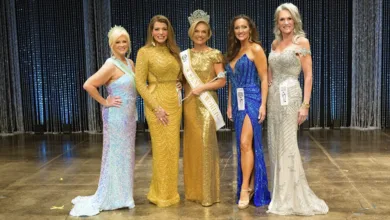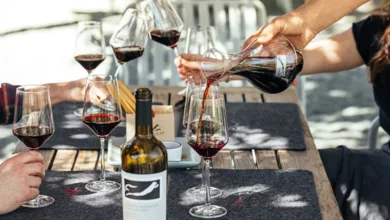
Photographs by: Marilyn Bishkin
Years ago, when people told her about their love for birding, Marilyn Bishkin smiled, a little perplexed by their enthusiasm.
“I’d think, ‘Oh, gosh, I can’t imagine,'” Bishkin says now. “I didn’t understand. I didn’t understand how birds can enthrall you. But once you start, you can’t stop.”
And anyone who has ever happened upon one of her gasp-worthy, goosebumps-inducing, detail- and color-abounding photos of birds in flight, landing on water, or noshing on nectar is grateful for that. Her pictures exude awe, and you find yourself captivated by these creatures to whom you otherwise might not give much thought.
But Bishkin does. She reminds us that the most vibrant palette can’t be found in a box of crayons or on a hardware store paint swatch, that grace is innate, that the ability to fly is as mind-boggling as it is magical, and that birds are, in a nutshell, pretty darn amazing.

She says capturing them through the lens “is a bit of serendipity; you don’t know what you’ll get as you watch a wood duck float in a creek, in and out of light, in and out of shadow. I’m always watching to see what kind of new bird action I will see.”
After college, the self-described “bird nerd” started her career as a newspaper photographer in Rhode Island and Connecticut. Wanting to learn more, she earned a master’s degree in photojournalism and design from the University of Missouri. From there, she began her career as a designer at The Dallas Morning News, only periodically picking up her camera.

But retirement changed that. Bishkin began shooting and hasn’t stopped. Birds, her primary subjects, came into the picture in 2016 when she bought a long lens to perfect her flower photos. One day she decided to go to White Rock Lake to see what she could see. There she started talking to a fellow photographer who was focusing his lens on the sky.
“He’d tell me, ‘OK, get ready because the birds are preparing to come in,'” Bishkin recalls. “I wouldn’t see anything, and then, sure enough, there they were, getting closer and closer. He was so enthusiastic and got me enthusiastic. I spent hours that day shooting.”
When she got home and began looking at what she had shot, one especially enchanted her.
“A pelican had just landed on the water, and its wings were up,” she says. “It was kind of – ta-da! I was hooked.”

Now, bird photography has become almost an everyday activity. On frequent road trips to California, where their son Zac lives, Bishkin and her husband Steve visit nature preserves and national parks. Last year, on a trip to Costa Rica, they loved it so much that they decided to go to Ecuador this spring for a birding photography journey where she saw more than 100 new species, 180 overall, and shot 63,000 images. She recalls “parrots and toucans with vibrant blues, greens, and reds; and hummingbirds with iridescent rainbow colors.”
But plenty of birds are close to home, too. White Rock Lake has hundreds of species. So does her feeder—and fountain-filled backyard, where she’s counted close to 30 species of birds. At last count, she’d seen and photographed 537 species.

“I am an avid bird photographer,” she says. “Not a bird expert. I have a laundry list of backyard birds I know – cardinals, chickadees, and wrens – but I don’t generally stop when I’m shooting and look at a field guide because there’s so much going on, and I’m taking so many pictures.”
“I’m like a little kid; I can hardly wait,” Bishkin says. No matter the season, she loves getting out in nature. There’s never a bad day.
“Winter birding is great because the leaves are gone, and birds are in the branches,” she says. “In Spring at White Rock, a field of wildflowers attracts at least three species — Eastern and Western Kingbirds and Scissor-tailed flycatchers, all going after seeds in the flowers and bugs in the air. It is a thing to behold.”

To hear her talk and to see her photos, every bird is a work of art, a star, an intricate and unique creation of feathers, patterns, symmetry, and style.
“When I’m out shooting birds, I’m always super happy and at peace,” she says. “It’s something to look forward to all the time. It’s always on my mind. I never would have thought that would be true.”

You don’t need to be an expert to love and be invigorated by birds. Here are Bishkin’s tips for finding and photographing them.
- Fancy equipment is optional. A pair of binoculars, a field guide, and a sense of adventure are plenty to start. A camera with a long lens will come in handy when you’re ready to start shooting.
- Know when to go. In the early morning and late afternoon, birds tend to be looking for food. The light tends to be softer then, too.
- Be still and listen. Determine where the bird sounds are coming from, then quietly walk toward them. That’s obvious at a lake, not so much in a forest or along a creek. Check out dead trees, high wires, and treetops.
- Choose your camera wisely. A smartphone isn’t your best option. Invest in a DSLR or mirrorless camera. Bishkin recommends at least a 300 mm lens; she uses a 500 mm or 800 mm for intricate details.
- Use a high shutter speed and low aperture. Try a shutter speed of 1/2000th to 1/3200th of a second to capture moving birds and an aperture of f4 or f5.6 to make the bird stand out from the background.
- Focus on the bird’s eye ring. When you talk to someone, you focus on their eyes. The same goes for photographing birds.





